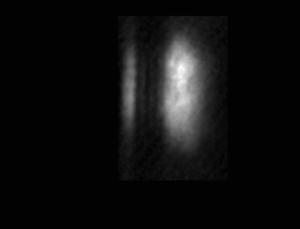An artificial black hole that traps sound instead of light has been created in an attempt to detect theoretical Hawking radiation. The radiation, proposed by physicist Stephen Hawking more than 30 years ago, causes black holes to evaporate over time.
Astrophysical black holes are created when matter becomes so dense that it collapses to a point called a singularity. The black hole's gravity is so great that nothing – not even light – can escape from a boundary around it called an event horizon.
But physicists have also been developing 'black holes' for sound. They do this by coaxing a material to move faster than the speed of sound in that medium, so that sound waves travelling within it cannot keep up, like fish swimming in a fast-moving stream. The sound is effectively trapped in the stream-like event horizon.
Quantum state
The materials physicists are focusing on are called Bose-Einstein condensates (BECs), a quantum state of matter where a clump of atoms behaves like a single atom.
Condensates have been made that move supersonically before, so physicists have likely created acoustic black holes in the process of working with BECs, says Eric Cornell of the University of Colorado at Boulder, who shared a 2001 Nobel Prize for the development of Bose-Einstein condensates.
But he says a new study by Jeff Steinhauer of the Technion-Israel Institute of Technology in Haifa and colleagues is the first documented experiment directly aimed at producing Hawking radiation in a BEC.
Supersonic flow
The team cooled 100,000 or so charged rubidium atoms to a few billionths of a degree above absolute zero and trapped them with a magnetic field. Using a laser, the researchers then created a well of electric potential that attracted the atoms and caused them to zip across the well faster than the speed of sound in the material.
This setup created a supersonic flow that lasted for some 8 milliseconds, fleetingly forming an acoustic black hole capable of trapping sound.
The implications of such work could be profound, as it could lead to the first detection of Hawking radiation.
Quantum mechanics says that pairs of particles can spontaneously appear out of empty space. These pairs, which consist of a particle and its antiparticle, should exist for a fleeting moment before they annihilate each other and disappear.
But in the 1970s, Hawking proposed that if the pair was created near the edge of a black hole, one particle might fall in before it is destroyed, leaving its partner stranded outside the event horizon. To observers, this particle would appear as radiation. In acoustic black holes, Hawking radiation would take the form of particle-like packets of vibrational energy called phonons.
Big boon
Finding Hawking radiation would be a big boon for physics, says cosmologist Sean Carroll of Caltech. "For one thing, Stephen Hawking would win the Nobel Prize," Carroll told New Scientist. "But it would more just show us that we're on the right track."
That's because Hawking's theory makes some fundamental propositions about how quantum mechanics works in space that is curved by gravity. The underlying math is used to calculate how the universe behaved during a period called inflation, when space rapidly expanded soon after the big bang.
Detecting Hawking radiation through astronomical observations, however, is difficult, because the evaporation of typical black holes is obscured by higher-energy sources of radiation, including the cosmic microwave background, the afterglow of the big bang.
'First step'
And researchers still have a way to go before they can detect Hawking radiation in acoustic black holes. Steinhauer's team, for example, estimates that the boost in velocity that atoms get in their setup must be about 10 times bigger in order to create detectable Hawking radiation in the form of phonons.
"Actually detecting the sound waves produced by the hole is really tough. But this is an exciting first step," says Bill Unruh of the University of British Columbia in Vancouver, Canada, who first proposed the idea of using quantum fluids to create artificial event horizons.
Cornell agrees, adding that the team needs to make the BEC flow much more smoothly in order to measure the subtle sign of Hawking radiation. "What they've done is kind of the easy part," he told New Scientist. "The hard part is to do that in such a quiet way that you can see all the tiny fluctuations on top of all the violent things you've done to the condensate [to make it go supersonic]."
Cornell and his colleagues are building their own experimental setup to produce acoustic event horizons.
Laser pulses
And others hope to produce detectable Hawking radiation in the lab using light. In 2008, a team created an artificial event horizon in an optical fibre, exploiting the fact that different wavelengths of light move at different speeds in the fibre.
They did this by sending a relatively slow-moving pulse down the fibre. This distorted the fibre's optical properties, so that when a second, faster pulse caught up with the first one, it was slowed down and effectively became trapped behind the event-horizon-like leading edge of the first pulse.
An astrophysical detection of Hawking radiation may still be possible. The smaller a black hole is, the higher the energy its Hawking radiation is. So the evaporation of microscopic black holes that some researchers suspect were created almost immediately after the big bang might be detectable using NASA's Fermi Gamma-ray Space Telescope, which launched in 2008.

By accelerating atoms across the dark gap at the centre of this image,
researchers think they might be able to create an acoustic black hole capable of
producing the first detectable Hawking radiation (Image: O. Lahav et al.)
(From http://www.newscientist.com/article/dn17319-physicists-create-black-hole-for-sound.html)